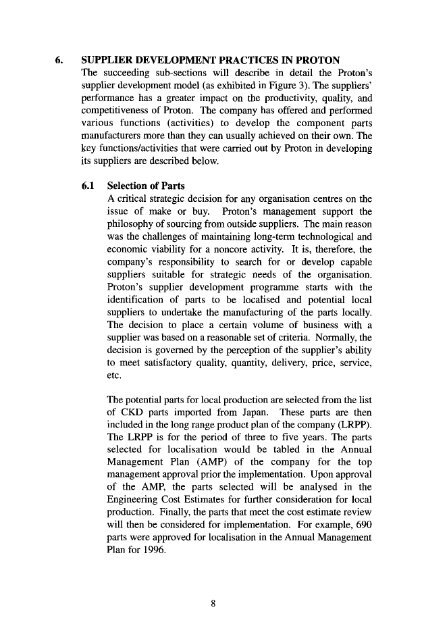(jit) principles and systematic layout planning as tools to improve ...
(jit) principles and systematic layout planning as tools to improve ...
(jit) principles and systematic layout planning as tools to improve ...
Create successful ePaper yourself
Turn your PDF publications into a flip-book with our unique Google optimized e-Paper software.
6. SUPPLIER DEVELOPMENT PRACTICES IN PROTON<br />
The succeeding sub-sections will describe in detail the Pro<strong>to</strong>n's<br />
supplier development model (<strong>as</strong> exhibited in Figure 3). The suppliers'<br />
performance h<strong>as</strong> a greater impact on the productivity, quality, <strong>and</strong><br />
competitiveness of Pro<strong>to</strong>n. The company h<strong>as</strong> offered <strong>and</strong> performed<br />
various functions (activities) <strong>to</strong> develop the component parts<br />
manufacturers more than they can usually achieved on their own. The<br />
key functions/activities that were carried out by Pro<strong>to</strong>n in developing<br />
its suppliers are described below.<br />
6.1 Selection of Parts<br />
A critical strategic decision for any organisation centres on the<br />
issue of make or buy. Pro<strong>to</strong>n's management support the<br />
philosophy of sourcing from outside suppliers. The main re<strong>as</strong>on<br />
w<strong>as</strong> the challenges of maintaining long-term technological <strong>and</strong><br />
economic viability for a noncore activity. It is, therefore, the<br />
company's responsibility <strong>to</strong> search for or develop capable<br />
suppliers suitable for strategic needs of the organisation.<br />
Pro<strong>to</strong>n's supplier development programme starts with the<br />
identification of parts <strong>to</strong> be localised <strong>and</strong> potential local<br />
suppliers <strong>to</strong> undertake the manufacturing of the parts locally.<br />
The decision <strong>to</strong> place a certain volume of business with a<br />
supplier w<strong>as</strong> b<strong>as</strong>ed on a re<strong>as</strong>onable set of criteria. Normally, the<br />
decision is governed by the perception of the supplier's ability<br />
<strong>to</strong> meet satisfac<strong>to</strong>ry quality, quantity, delivery, price, service,<br />
etc.<br />
The potential parts for local production are selected from the list<br />
of CKD parts imported from Japan. These parts are then<br />
included in the long range product plan of the company (LRPP).<br />
The LRPP is for the period of three <strong>to</strong> five years. The parts<br />
selected for localisation would be tabled in the Annual<br />
Management Plan (AMP) of the company for the <strong>to</strong>p<br />
management approval prior the implementation. Upon approval<br />
of the AMP, the parts selected will be analysed in the<br />
Engineering Cost Estimates for further consideration for local<br />
production. Finally, the parts that meet the cost estimate review<br />
will then be considered for implementation. For example, 690<br />
parts were approved for localisation in the Annual Management<br />
Plan for 1996.


